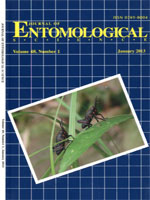Laboratory assays were conducted to assess the potential of pymetrozine, a novel azomethine pyridine insecticide, against the brown planthopper, Nilaparvata lugens (Stål) (Homoptera: Delphacidae). All nymphal instars were treated with the pymetrozine concentrations of 400, 200, 100, 50, 25 mg/l, and then maintained in incubators at 26 ± 1°C on a photoperiod of 16:8 h (L: D). At 24, 48, 72, and 120 h after treatment, mortality was recorded. Greater numbers of nymphs were killed at a faster rate with the higher concentrations (mortality of 70.7% with 400 mg/l and 63.8% with 200 mg/l at 24 h, first -second) than at the median concentrations (mortality of 51.7% with 100 mg/l and 50% with 50 mg/l at 24 h, first -second) and the lower concentration (mortality of 25.9% with 25 mg/l at 24 h, first -second), whereas mortality in the control remained low (3.3% with distilled water at 24 h, first -second). The first and second instars were the most susceptible with median lethal concentrations [LC50] of 76.3, 35.5, 26.6 and 21.96 mg/L at 24, 48, 72 and 120 h after treatment, respectively. Fifth-instars were the least susceptible with the LC50 values of 5,887.53, 758.41, 236.15 and 67.23 mg/L at 24, 48, 72 and 120 h after treatment, respectively. The LC50s of the third - fourth instars were 1737.89, 601.6, 96.21 and 50.14 mg/L at 24, 48, 72 and 120 h after treatment, respectively, and were significantly greater than those of the first - second instars. These results indicate that pymetrozine would be an effective alternative for the control of brown planthopper.
BioOne.org will be down briefly for maintenance on 17 December 2024 between 18:00-22:00 Pacific Time US. We apologize for any inconvenience.
How to translate text using browser tools
1 January 2013
Toxic Effects of Pymetrozine on the Brown Planthopper, Nilaparvata lugens (Stål) (Homoptera: Delphacidae)
Jie Liu,
Jie Zhang,
Xiaowa Qin,
Yong Chen,
Fenghui Yuan,
Runjie Zhang
ACCESS THE FULL ARTICLE





